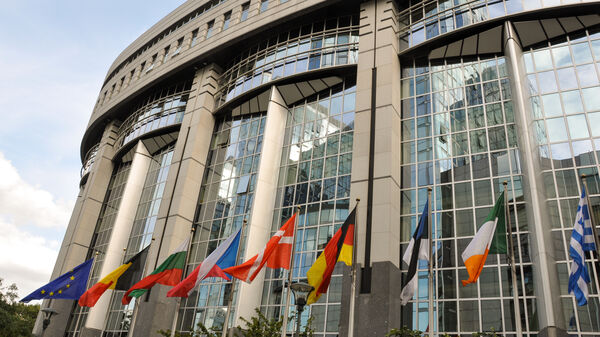Brussels: The Would-Be Capital of Europe
After enjoying Brussels' artistic and chocolatey treats, consider a visit to the European Parliament: an eye-opening opportunity to appreciate the mostly realized dream of European unity.
By Rick Steves
When my grandparents were kids, Europe was still being wracked by 500 years of virtually uninterrupted warfare. Today Europeans are known — sometimes even mocked — for their pacifistic ways. What a transformation!
The change is due in no small part to the clunky, imperfect, but still (to me) awe-inspiring European Union. In 2012, the Nobel Peace Prize was given to 500 million people who have, for the last several decades, made a conscious decision to live together in peace and harmony. In the words of the Nobel Committee, "The EU has helped to transform most of Europe from a continent of war to a continent of peace." Who could possibly be more deserving of a peace prize?
Just as the EU has transformed Europe, it has also transformed Brussels. Once a minor trading hub, today Belgium's capital is multicultural, hosting politicians and businesspeople (and immigrants) from around the globe — and featuring a world of ethnic restaurants. The city hosts 400 embassies (the US has three here, one each for the EU, NATO, and Belgium) and every sizable corporation has a lobby in Brussels.
The EU HQ is changing the demographic makeup of the city. The EU is the largest multilingual operation on the planet. And as it tries to accommodate its 24 official languages (and it does, in some ways), the practical language of European governance has become English. The EU has had such an impact on Brussels that some say in a generation, English will become the city's first language.
Despite these changes, Brussels remains a rich, chocolaty mix of food and culture. Tourists usually make a beeline to Brussels' Grand Place — my favorite town square in northern Europe — then blitz the city's art museums, and get their pictures taken in front of the famous Manneken-Pis peeing-boy statue.
But visitors should consider Brussels' EU sights as well. A short bus or Métro ride from the Grand Place is the European Parliament, a sprawling complex of glass skyscrapers with a babel of black-suited politicians speaking all the different Euro-languages. It's exciting just to be here — a fly on the wall of a place that aspires to chart the future of Europe "with respect for all political thinking…consolidating democracy in the spirit of peace and solidarity."
The high-tech, informative museum called the Parlamentarium makes for a smart visit before seeing the Parliament. While its interactive exhibits are rather dry, it offers a good introduction to the EU. You can learn about how the EU came to be and the many challenges it has faced by "meeting" virtual EU parliamentarians, casting your own vote regarding recent hot-button EU issues, and getting a rundown of each EU country's culture, commerce, and contemporary challenges.
The only way to get inside the European Parliament itself is to join a free one-hour tour with a multimedia guide. As you tour the complex at your own pace, you'll learn how early visionary utopians (like Winston Churchill, who in 1946 called for a "United States of Europe") led the way as Europe gradually evolved into the European Union.
The balcony overlooking the building's lobby affords a good view of a giant sculpture, titled Confluence, with moving metal-wire pieces — representing people coming together for a common purpose. The building itself is in line with EU idealism: It's functional, transparent, and very "green."
The grand finale of a parliament visit is the vast "Hemicycle," where parliamentarians, representing about 160 national political parties and organized into voting blocs based on political ideals (rather than nationality), hash out pan-European issues.
If you tour the headquarters, consider this: You're at the heart of one of the biggest, most powerful, and most idealistic states in the world (and, arguably, in history). In just one generation, more than two dozen European countries have gone from being bitter rivals to compatriots. This union of such a diverse collection of separate nations — with different languages, cultures, and soccer teams — is almost unprecedented.
Not every EU citizen is convinced that the union is a good thing. The continent is full of "Euroskeptics," and the UK's stunning 2016 vote in favor of Brexit shook the union's foundations when several other EU nations were already debating similar referendums. Critics chafe at the highly regulated business environment and high taxes, complain about the bureaucracy, want to make their own decisions about controling their borders, feel burdened by their economic interdependence, and generally worry that their national cultures will be swallowed up.
Still, Europeans don't want to go back to the days of division and strife. And a visit to Brussels and the EU headquarters backs my firm belief that most Europeans believe as fiercely in unity, cooperation, and celebrating diversity as Americans believe in life, liberty, and the pursuit of happiness.

